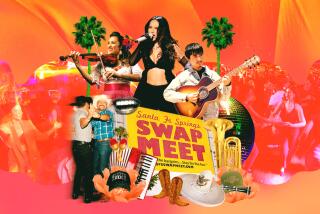States of the Art
Would you like your children to learn the iguana dance?
The Autry Museum of Western Heritage invites kids and families to learn bailes, Mexican regional dances Saturday.
“We have presented many performances of Mexican dance here,” says Allison Meyer, the Autry’s education coordinator, “but not offered the public the opportunity to learn them.”
Argelia Andrade, who manages three folkloric dance groups in the Los Angeles area, two at UCLA where she is a student and one in Gardena where she is a community activist, will teach the regional music and dance of Mexico.
Coordinating the work of the Grupo Folklorico de UCLA, a decades-old Mexican mestizo dance ensemble, says Andrade, has familiarized her with the range of dances in Mexico’s 31 states.
“I really want to share that with the children,” she says. While teaching the Autry class, she will use the instructional skills she’s honed during her two years as leader of Nuestras Raices Ballet Folklorico, a group of 40 kids, ages 5 to 18, in her hometown of Gardena.
The iguana dance is native to the lush, jungle-covered state of Chiapas, on the Isthmus of Mexico. The music, featuring the marimba, evolved from an instrumental tradition inherited from Africans who were brought to the region centuries ago, Andrade explains.
Mexico has absorbed music and dance influences from many places.
The oldest and best-known of the regional dances originates in Jalisco and Guadalajara, she says, and features “Spanish footwork and skirt movement.”
The harp, an instrument in use in 1519 when Spain established its oldest settlement in Mexico at Vera Cruz, features prominently in the music of that town.
When France imposed a monarchy on Mexico in the 1800s, Austria’s Emperor Maximilian introduced Bohemian-style oom-pah-pah music and accordions to the country, while French occupation troops brought in concertinas.
The emperor was eventually deposed and the French driven out, but the musical influence left by these Europeans can still be heard in the norteno music and dance of Chihuahua, Mexico’s largest state.
Horseback riding became a theme in the dance culture of Aguascalientes and Jalisco, involving dance steps that mimic galloping and lassoing. Saturday, kids will be able to learn these steps.
The influence of the native, pre-Columbian culture of Mexico will be evident in several of the dances of Michoacan, Andrade says.
BE THERE
“Danza Mexicana,” 10 a.m.-12:30 p.m. Saturday, Autry Museum of Western Heritage, 4700 Heritage Way, Los Angeles. Class presented in English and Spanish. Children under 11 must be accompanied by an adult. Preregistration required; $7 for kids 12 and under; adults $10; for museum members: $8 adults, $5 kids. Information: (213) 667-2000, Ext. 341.
More to Read
The biggest entertainment stories
Get our big stories about Hollywood, film, television, music, arts, culture and more right in your inbox as soon as they publish.
You may occasionally receive promotional content from the Los Angeles Times.










